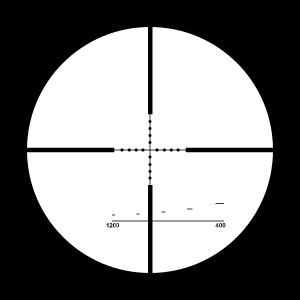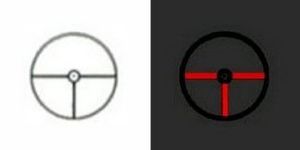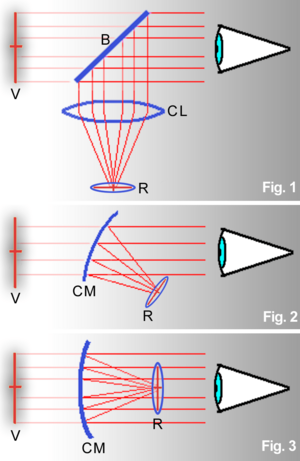Reticle facts for kids
A reticle (say: RET-ih-kul), also known as a graticule (say: GRAT-ih-kyool), is a special pattern of lines or markings. You can find these patterns inside the eyepiece of optical tools. Think of things like telescopes, microscopes, or even the screen of an oscilloscope.
These patterns help people measure things or aim accurately. Imagine a tiny ruler or target built right into your view! Today, these lines can be etched onto glass or even shown as a digital image on a screen. The word reticle is often used for patterns in weapon sights. Graticule is more common for measuring tools like those used in astronomy or surveying.
One of the most basic reticle patterns is the crosshair. This looks like a plus sign ("+") with two lines crossing each other. But many crosshairs have extra features like dots, circles, or special marks. Crosshairs are famous for helping aim firearms. They are also used in astronomy and surveying. Even on computers, your mouse pointer might look like crosshairs for precise clicking! People believe the reticle was invented in the 1600s by either Robert Hooke or William Gascoigne.
What are Reticles Used For?
Reticles are super useful in many different tools. They help us see things more clearly and make accurate measurements.
Reticles in Firearms
When you think of crosshairs, you probably think of telescopes on firearms, often called scopes. Movies and TV shows often show what it looks like to aim through crosshairs. This has made them very well-known.
Different Shapes of Reticles
The first crosshairs were very thin lines. These are great for aiming precisely at targets that stand out. But thin lines can be hard to see against busy backgrounds, like when hunting. Thicker lines are easier to spot.
Many modern scopes use a duplex crosshair. This design has thick lines around the edges that become thin in the middle. The thick parts help your eye quickly find the center. The thin lines in the middle allow for very precise aiming. Some duplex reticles can even help you measure distances! For example, a "30/30 reticle" has thin bars that cover about 30 inches at 100 yards. This helps experienced shooters guess how far away an object is.
How are Reticles Made?
Reticles can be made in different ways. Each method has its own benefits.
Wire Crosshairs
Long ago, crosshairs were made from real hair or spiderwebs! These materials were very thin and strong. Today, many scopes use thin wires for crosshairs. These wires can be flattened to make them wider or thinner. Wire reticles are usually silver but look black when light shines through the scope. They are tough and let a lot of light pass through.
Etched Glass Reticles
In the 1700s, Philippe de La Hire suggested etching lines onto glass with a diamond. Many modern crosshairs are etched onto a thin piece of glass. This allows for many more shapes and designs. Etched glass reticles can have "floating" parts, like circles or dots, that don't go all the way across. Some even have complex sections to help estimate distance or adjust for how bullets drop. A small amount of light might be lost with glass reticles, but modern ones have special coatings to prevent this.
Illuminated Reticles
Some reticles can light up! They might use a plastic tube to gather light from around them. In low light, a battery-powered LED (Light Emitting Diode) can make them glow. Some sights even use a special material called tritium that glows for many years without a battery. Red is a common color for illumination because it helps preserve your night vision. However, some products offer green or yellow light too.
Reticle Placement: Focal Plane
In a variable power scope (one where you can change the zoom), the reticle can be in one of two places:
- First Focal Plane (FFP): The reticle stays the same size compared to the target. So, if you zoom in, the target gets bigger, and the reticle lines also appear to get thicker in relation to the target. This is useful for range estimation at any zoom level.
- Second Focal Plane (SFP): The reticle stays the same size to your eye, no matter how much you zoom in or out. The target image grows and shrinks behind it. Most American scopes use SFP because users prefer the reticle to look constant.
Collimated Reticles
Reflector sights (also called reflex sights) create a "collimated" reticle. This means the reticle appears to be floating far away, almost at infinity. This makes it easy to aim with both eyes open. These sights are used on surveying tools, telescopes, and firearms. Modern versions, called red dot sights, use LEDs and are very popular on small firearms.
Holographic Reticles
Holographic weapon sights use a hologram to create the reticle image. A laser diode lights up this hologram. One cool thing about holographic sights is that they fix a problem called parallax that some other sights have. They also allow for almost any reticle shape. However, they can be heavier and use more battery power. Like red dot sights, holographic sights are also common on small firearms.
Reticles in Surveying and Astronomy
Reticles are also very important in other fields like surveying and astronomy.
Surveying
In surveying, tools like levels and theodolites use reticles. These reticles might have special marks called stadia marks that help surveyors measure distances on the ground.
Astronomy
For astronomy, reticles can be simple crosshairs or more complex designs. Telescopes used for polar alignment (lining up with the Earth's axis) might have a reticle that shows where Polaris (the North Star) should be. Very precise telescopes might use a filar micrometer as a reticle. This can be adjusted to measure tiny angular distances between stars.
Reflex sights are also popular for aiming telescopes at objects in the sky. They make it much easier to point the telescope exactly where you want it.
The constellation Reticulum (which means "little net" or "reticle") was named to honor the reticle and its help in astronomy.
Images for kids
See also
 In Spanish: Retículo (pieza) para niños
In Spanish: Retículo (pieza) para niños







